
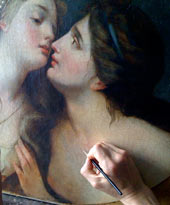
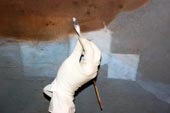
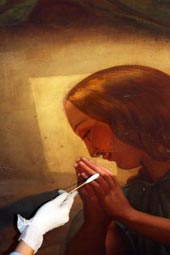
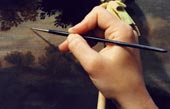
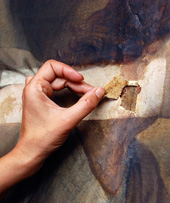
Work Methodology
Conservation of the paint layer
As a restorer of cultural heritage, Cecile Charpentier has always observed the greatest rigor with regard to the principles inherent to her profession: stability, reversibility, legibility. She only undertakes the restorative interventions indispensable to the survival of the work and always in full respect of the latter.
Cecile Charpentier regularly chooses the most suitable materials, solvents, or mixtures of solvents, and the most scientific methods to ensure the preservation of the painting. Since she works on paint layers of different types and from different periods, she identifies the composition of the paint layers and carefully studies the previous restorations.
Cecile Charpentier never applies procedures if the reversibility and stability are not fully ensured.
1. Photographic documentation
Before any intervention, photographs are taken: general views and details. These photos are digitalized and the images processed to be as close as possible to reality.
2. Removal of surface dirt
Dusting the entire surface of the work is performed with a soft brush (Japanese or Chinese goat-hair brush), accompanied, if necessary, by a slight vacuuming of the canvas or wood.
3. Cleaning
Sample tests are performed and shown to the client before the actual restoration. This operation is conducted before varnish removal. The choice of the least invasive technique is always suggested: an aqueous solution or a weak solvent.
4. Partial removal of old varnish
It is necessary to use extreme caution when removing the old varnish covering the paint layers so as not to violate the integrity of the work.
Thus, in order to preserve the glaze surface and save the warm golden tone of some paintings, it is essential to maintain a thin covering of old varnish. Prior to reducing the old varnish, tests are carried out with solvents or solvent mixtures.
The old varnish is then reduced selectively: in areas where whites and light tones dominate, less pronounced in the shadows and where the colors are darker.
5. Removing overpaints
The first step is to delimit the areas presenting overpaints. The overpainting may hide filler that had been placed over an accident, and, in turn, had covered some of the original painting. A series of tests is carried out on different areas. Then, if the client is in agreement, the overpaints are eliminated with suitable solvents or by scraping them off with a scalpel, using a magnifying glass, after having been previously softened up.
6. Treatment of old filler
The old filler that overlaps the original paint layer must be smoothed out or eliminated. The most suitable product is chosen to fill in the lacunae. The new filler is surfaced to blend in with the canvas, recreating the network of craquelures. This process obtains homogeneity throughout the paint layer.
7. Pictorial reintegration
In order to repair the damages to a painting and carry out the illusionist repainting to fill in the lacunae, Maïmeri colors are used, diluted in Nitro. For pictorial recreations of missing areas, the same colors are used, diluted in diacetone alcohol-ethanol, less volatile and able to reproduce the modeling. The work is performed by applying a glaze replicating the original material. For Italian primitives, a technique called tratteggio with Maïmeri colors is also used; and sometimes, even watercolor is applied taking into account the repair to be undertaken.
8. Varnishing
Using a wide spalter allows the restorer to extend and equalize the entire surface in order to start overpainting and obtain the desired luminosity. The use of various varnishes, either based on natural resins for old paintings, or acrylic synthetic resin for more recent paintings, the most frequent: Talens Glossy Varnish diluted in white spirit. The final coat of varnish can be applied with an airbrush to project the varnish.
9. Reaffixing
The occasional blisters and raised areas are treated with an adhesive compatible with the substances that comprise the painting. These operations are conducted in parallel to those required by the support (lining, relining...). The adhesives are selected based on the appearance of the paint layer and the type of support.
10. Preparation and presentation of the restoration report to the client
A detailed photographic record notice with specifications on the products used is prepared and submitted with the report of the restoration.
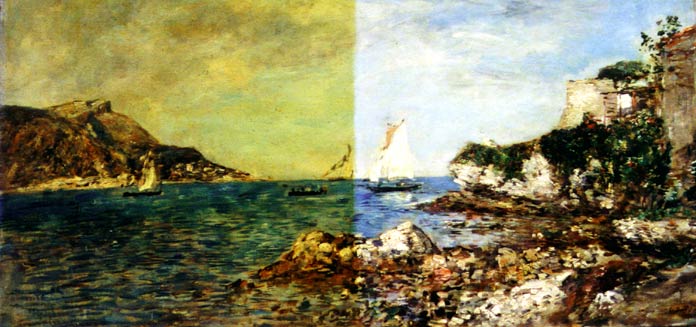
Painting of Eugene Boudin being cleaned
